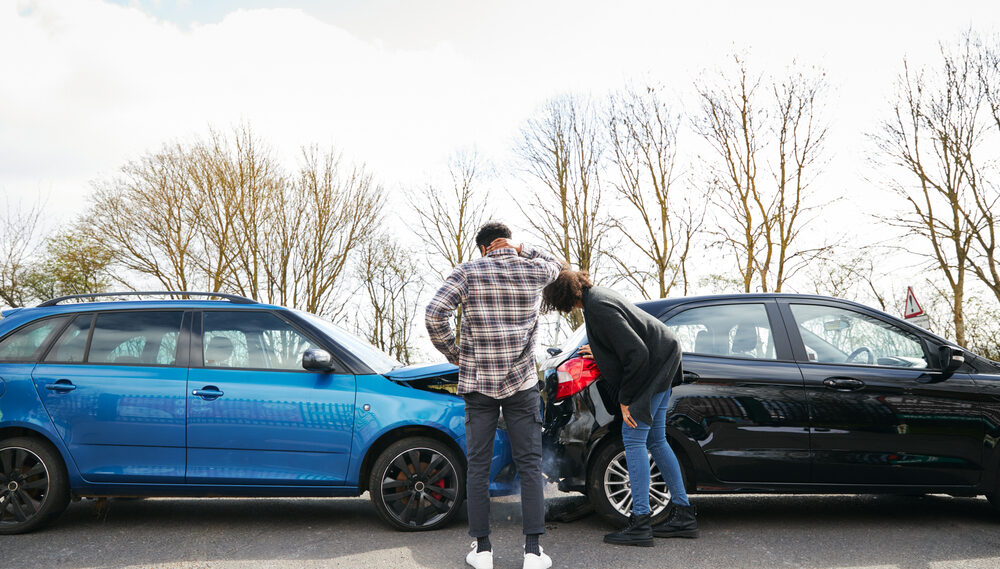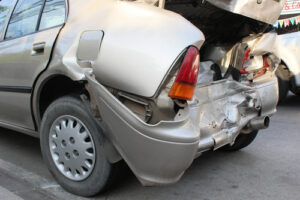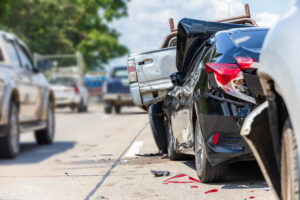
A sudden rear-end collision isn’t just an inconvenience; it’s a disruption that forces you to confront immediate and often complex challenges. These unexpected injuries bring medical bills and lost income, adding immense stress. You shouldn’t have to face this alone.
A trusted Bakersfield car accident lawyer for more than 30 years, Mickey Fine and his team at The Law Offices of Mickey Fine have helped countless injury victims navigate the aftermath of rear-end crashes. Our firm handles everything from evidence gathering to insurance negotiations, working to secure the full compensation you’re entitled to.
Why Rear-End Collisions Happen So Frequently in Bakersfield
Common Causes on Bakersfield’s Busy Roads
Distracted driving causes approximately 9% of all fatal crashes and 15% of injury crashes nationwide according to the National Highway Traffic Safety Administration. This dangerous behavior significantly contributes to rear-end collisions on Bakersfield’s busy roads.
Following too closely ranks as the second major factor. California Vehicle Code Section 21703 requires drivers to maintain reasonable distances, but rushed commuters often ignore this safety rule on congested routes like Highway 178 and Rosedale Highway.
Aggressive driving behaviors contribute significantly to rear-end crashes. Speeding drivers cannot stop in time when traffic slows unexpectedly.
High-Risk Areas in Kern County
Downtown Bakersfield experiences heavy rear-end collision rates during peak commuting hours. The intersection of Chester Avenue and Truxtun Avenue sees frequent stop-and-go traffic that catches drivers off guard.
Highway 99 through Bakersfield presents unique challenges with merging traffic and sudden slowdowns. Construction zones along this major corridor create bottlenecks where rear-end accidents spike dramatically.
Hidden Injuries That Appear Days After Your Rear-End Collision
Common injuries after being rear-ended may not be immediately obvious. The following are some of the most frequently overlooked injuries that often surface hours or even days after the crash.
Whiplash and Neck Injuries
Whiplash represents one of the most common injuries in rear-end collisions. According to the National Highway Traffic Safety Administration, rear-end crashes account for approximately 29% of all police-reported traffic crashes. This soft tissue injury occurs when your head snaps forward and backward during impact, stretching neck muscles and ligaments beyond normal limits.
Symptoms often develop 24 to 72 hours after your accident. Initial adrenaline masks pain, creating false impressions that you escaped injury. Neck stiffness, headaches, and shoulder pain gradually intensify as inflammation increases.
Back and Spinal Injuries
Rear-end impacts compress spinal vertebrae, potentially causing disc herniations or fractures. Lower back injuries prove especially common when seat positioning or impact angle concentrate forces on the lumbar spine.
Diagnostic imaging often reveals spinal injuries invisible during initial examinations. MRI scans and CT scans detect disc problems, nerve compression, and structural damage that X-rays miss completely.
Traumatic Brain Injuries from Impact
Traumatic brain injuries occur in rear-end collisions when your brain strikes the skull during sudden acceleration and deceleration. Concussions develop even without direct head contact during impact.
Symptoms include confusion, memory problems, headaches, and balance issues. Cognitive difficulties affect work performance and daily activities for weeks or months following your accident.
When to Seek Medical Attention Immediately
Emergency medical care becomes necessary if you experience severe neck pain, numbness in arms or legs, or loss of consciousness. These symptoms indicate potential spinal cord or brain injuries requiring immediate intervention.
Delayed symptoms still warrant prompt medical evaluation. Waiting weeks to see a doctor creates documentation gaps that insurance companies exploit to minimize your claim value.
California Law and Fault in Rear-End Accidents
Understanding who’s at fault for a rear-end accident in California is critical to securing fair compensation. This section explains how fault is determined and when exceptions may apply under state law.
Presumption of Fault for the Rear Driver
California Vehicle Code Section 21703 establishes that following drivers must maintain safe distances to avoid collisions. This creates a legal presumption that rear drivers bear fault for rear-end accidents in most circumstances.
The presumption of fault means insurance companies may accept liability for rear-end collisions without extensive investigation. This legal advantage helps victims recover compensation more efficiently than other accident types.
Exceptions to the Rear Driver Rule
Sudden lane changes immediately before impact might shift fault to the front vehicle. California recognizes that drivers who cut into traffic without adequate space create unavoidable collision situations.
Multi-vehicle chain reactions complicate fault determination in rear-end accidents. The initial impact vehicle bears primary responsibility, but subsequent drivers might share liability for additional impacts.
Comparative Negligence in California
California follows pure comparative negligence rules under Civil Code Section 1714. This means your compensation reduces by your percentage of fault, but you still recover damages even if you’re partially responsible.
Insurance companies often allege comparative negligence to reduce claim values. Having experienced legal representation protects against unfair fault allocation that diminishes your rightful compensation.
Protecting Your Rights: The Most Critical Dos and Don’ts After an Accident
The actions you take in the days following a rear-end collision in Kern County can have a profound impact on your ability to recover fair compensation. Insurance companies have a well-rehearsed strategy for minimizing payouts, and it begins the moment they learn about the accident.
Do NOT Talk to the Other Driver’s Insurance Adjuster
Within a day or two of the crash, you will likely receive a phone call from an insurance adjuster from the at-fault driver’s insurance company. They might say they want to “check in on you” or “get your side of the story.” They will almost always ask if you are willing to provide a recorded statement.
Your answer should be a polite but firm “no.”
You are under no legal obligation to speak to the other driver’s insurance company. Their adjuster is not your friend. Their job is to protect their company’s profits, and they are trained to find ways to devalue or deny your claim. What you say can directly influence how insurance adjusters determine fault, and even a casual comment can be used to shift liability onto you. During a recorded statement, they will ask leading questions designed to get you to:
- Admit partial fault for the accident.
- Downplay the severity of your injuries (“I’m just a little sore”).
- State facts that could be contradicted later.
- Give them access to your entire past medical history.
Anything you say can and will be used against you. The safest course of action is to tell them you will be speaking with an attorney and that your attorney will be in contact. Then, hang up the phone.
What You Can Do to Build a Strong Case in Kern County
While your attorney will handle the complex legal work, there are several steps you can take to gather evidence and strengthen your claim.
- Get a copy of the official accident report. If your accident occurred within city limits, this will be from the Bakersfield Police Department. For crashes on highways like the 99 or I-5, the report will be from the California Highway Patrol (CHP). This report contains key details and the officer’s initial assessment of fault.
- Take photos and videos. Use your phone to document everything. Take wide shots of the accident scene, photos of the damage to both vehicles from multiple angles, and clear pictures of any visible injuries you have, like bruises or cuts.
- Keep a simple journal. Every day, take a few minutes to write down your pain levels. Note how your injuries are affecting your ability to work, sleep, care for your family, or enjoy your hobbies. This journal becomes a powerful record of your day-to-day suffering.
- Track all of your expenses. Keep a folder with every bill, receipt, and invoice related to the accident. This includes medical co-pays, prescription costs, and mileage to and from doctor’s appointments. If you miss time from work, get documentation from your employer showing your lost wages.
Insurance Company Tactics You Need to Know
Quick Settlement Offers and Why to Avoid Them
Insurance companies contact rear-end collision victims within hours, offering quick settlements before injuries fully manifest. These initial offers typically cover only immediate vehicle damage and basic medical expenses.
According to the Insurance Research Council, represented claimants receive 3.5 times more compensation than unrepresented victims. This dramatic difference demonstrates why quick settlements rarely provide fair value.
Recorded Statements and Your Rights
Insurance adjusters request recorded statements claiming they need your version of events. These conversations actually seek admissions they can use to minimize or deny your claim entirely.
You have no legal obligation to provide recorded statements to the other driver’s insurance company. Politely decline these requests and refer them to your attorney for all communications.
What Compensation You May Recover in California
Medical Expenses and Future Treatment
California law allows recovery of all reasonable medical expenses related to your rear-end collision injuries. This includes emergency room visits, diagnostic tests, specialist consultations, physical therapy, and prescription medications.
Future medical expenses receive compensation when doctors provide clear prognoses requiring ongoing treatment. Medical liens from healthcare providers get resolved from settlement proceeds.
Lost Wages and Diminished Earning Capacity
Lost income compensation covers time away from work during recovery and medical appointments. Calculate these damages using your regular pay rate, including overtime and commission opportunities missed.
Self-employed individuals face unique challenges proving lost income. Tax returns, client contracts, and business records help establish compensation for missed business opportunities.
Pain and Suffering Linked to Physical Injuries
California permits pain and suffering damages only when connected to documented physical injuries. Emotional trauma, anxiety, and depression related to your injuries qualify for compensation under this requirement.
Keep detailed journals documenting pain levels, activity limitations, and emotional impacts. This documentation provides powerful evidence for maximizing pain and suffering compensation.
When You Need a Bakersfield Personal Injury Attorney
Warning Signs Your Case Requires Legal Help
If an insurance company denies fault in a clear case, it means you need a lawyer right away. Even if it seems obvious who is to blame, insurance companies might not agree. A good lawyer can help you get past these problems.
Serious injuries requiring extensive medical treatment warrant legal representation to ensure fair compensation. Hospital stays, surgeries, and long-term care needs create complex damage calculations that attorneys handle expertly.
Contact an attorney immediately if:
- Insurance companies offer unreasonably low settlements
- Your injuries prevent returning to work for extended periods
- The other driver was uninsured or underinsured
How Attorney Mickey Fine Handles Rear-End Collision Cases
Mickey Fine personally manages every aspect of your rear-end collision case from initial consultation through final resolution. Your case never gets passed to inexperienced associates or overwhelmed paralegals.
With over 30 years of legal experience, including previous work representing insurance companies, Mickey Fine understands defense strategies and counters them effectively. This insider knowledge provides significant advantages during settlement negotiations.
Timeline and What to Expect in Your Case
California’s Statute of Limitations
California Code of Civil Procedure Section 335.1 provides two years from your accident date to file personal injury lawsuits. Missing this deadline may forever bar your right to seek compensation through legal action.
Property damage claims have three-year limitation periods under California Code of Civil Procedure Section 338. Vehicle repair or replacement claims have longer deadlines than injury cases.
Settlement Negotiations vs. Trial
Most rear-end collision cases resolve through settlement negotiations without requiring trial proceedings. Insurance companies prefer avoiding trial costs and unpredictable jury verdicts when liability appears clear.
Settlement timing depends on medical treatment completion and full injury assessment. Trial preparation strengthens settlement negotiations even when cases ultimately resolve beforehand.
FAQ for Rear-End Collisions
How much is my rear-end collision case worth?
Case values depend on injury severity, medical expenses, lost wages, and pain and suffering damages. Minor soft tissue injuries might settle for thousands, while severe injuries requiring surgery might reach higher amounts. Mickey Fine evaluates each case individually based on medical records, treatment costs, and impact on your daily life.
How long does a rear-end collision case take to settle?
Most rear-end collision cases resolve within 6 to 18 months, but complex cases with severe injuries may take longer. Settlement timing depends on completing medical treatment, gathering evidence, and negotiating with insurance companies. Mickey Fine works efficiently while ensuring you receive maximum compensation.
Will hiring a lawyer cost me money upfront?
No. The Law Offices of Mickey Fine accepts rear-end collision cases on a contingency fee basis, meaning you pay no attorney fees unless your case recovers compensation. All case expenses are advanced by the firm and recovered from settlement proceeds, eliminating financial barriers to quality representation.
Can I sue if I was hit while stopped in traffic?
Absolutely. Being struck while stopped actually strengthens your case because it eliminates any question about your driving behavior. California law clearly places fault on drivers who fail to stop safely behind stationary vehicles. These cases often result in favorable settlements due to obvious liability.
Get the Aggressive Representation You Deserve
After a rear-end collision, you need to understand your rights and options. While you focus on recovering from your injuries, Mickey Fine fights aggressively for the compensation you deserve under California law.
The Law Offices of Mickey Fine has recovered millions for Bakersfield rear-end collision victims through persistent advocacy and thorough case preparation. Attorney Mickey Fine personally handles every aspect of your case, ensuring no detail gets overlooked.
Contact the Law Offices of Mickey Fine today at (661) 333-3333 for your free case evaluation. Don’t wait while evidence disappears and deadlines approach. Call now and let Mickey Fine start fighting for your future.
